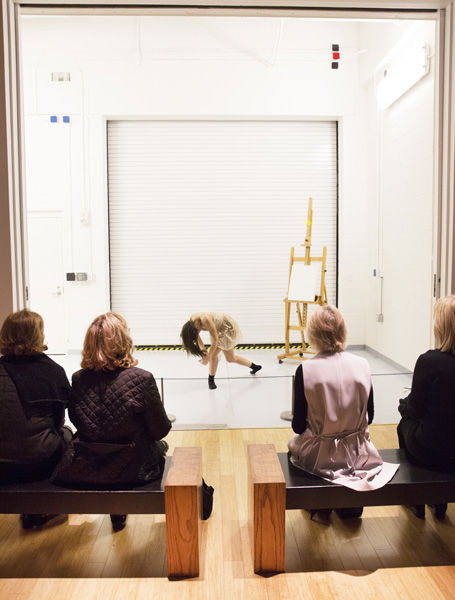Lucinda Gedeon, executive director of the Vero Beach Museum of Art, doesn’t tiptoe around her feelings for the founders of Ballet Vero Beach.
“I love these guys!” she declared with earnest, as an evening honoring the museum’s 30 years of existence was about to begin last Wednesday with a very unusual exhibition: a series of tableaux not on canvas but in space, danced and choreographed by members of Vero’s young ballet company.
“Museum in Motion” has had Ballet Vero Beach ballet master Camilo Rodriguez furiously inventing and artistic director Adam Schnell mischievously smiling for weeks now, knowing that their audience could not possibly envision in advance what was in store.
“A living exhibit out of dance,” Schnell called it.
“We want to celebrate through dance everything that this museum is to the community.”
He warned that the guests themselves might be the subject matter.
That was soon apparent with the first dance guests saw, when a woman seated primly at a café table in the lobby quickly became their doppelganger. In balletic gestures, dancer Alyssa Grimsley mimed texting, checking her watch, waiting for her companion then switched hats to become her. All the while, the museum’s real life café was visible behind her.
Only three of the seven dances were to music, and the sound drifted through the open galleries in a faintly dissonant layering, just as each curated exhibit of art might set off a certain pattern of thoughts that linger when the viewer moves on.
Schnell had slipped away from the gathering guests to go cue his dancers to begin, a full five minutes before anyone was actually watching. By the time the dancers left their posts to gather for a finale in the museum’s atrium, they had been in non-stop motion, much like a looping video, for fully 40 minutes.
Even Rodriguez was drained. It seemed he was only miming fatigue as he trudged through the lobby lugging his folded chair, dressed as a security guard – the identical uniform as the hyper-realistic sculpture of a guard that is a fixture in the far corner of the far gallery, the Stark. Rodriguez, who always dances brilliantly, would park his chair on his meanderings and then move all around and over it, a slow-motion embrace. Rodriguez hyped that hyper-realism when, head bowed beneath his cop’s cap, a single bead of sweat slid past his glasses and dropped to the marble floor. Clearly his job was harder than the Stark guy’s.
Other dancers agreed. “I’m just drinking water after water,” panted Claire Goodwillie, as she chatted with audience members who sipped white wine at a reception following the dances. Her solo, “Everyman,” was held in the Titelman Gallery currently hosting John Baeder’s photographs, “American Roadside.” The photos inspired her jazz-influenced movements, set off by a midriff-baring French sailor’s shirt and cropped tight jeans.
Matthew Carter also pled exhaustion, though he seemed as serene as his beautiful duet danced with Amaris Sharratt in the light-filled rotunda. “What Does It Mean?” was choreographed by Chloe Watson, a fellow company member in Ballet Nebraska, which shares its dancers with Ballet Vero Beach. At one point, Carter and Sharratt, dressed in white linen, executed a lovely lift facing away from the gathered spectators, who saw beyond them two more figures seated on a bench – the outdoor sculpture through the rotunda window.
Elsewhere, Chloe Watson, dancing this time, grappled with a blank canvas in “Getting it Right,” lifting it off its easel and moving the plane through space – a mirror, a partner, a mental block.
And in the Holmes Gallery, recently hung with the very serious 19th century paintings of Martin Johnson Heade, a couple of very unserious visitors: two fussing children plopped on bean bag chairs and their more or less oblivious mother. They were dancers, of course, doing their best to look annoying.
“Not that the museum is going to want to trot this out at every anniversary,” said Schnell, “but I wanted to show the audience that there’s a whole level at this place besides the art, where what you’re seeing isn’t necessarily about what’s on the walls.”

